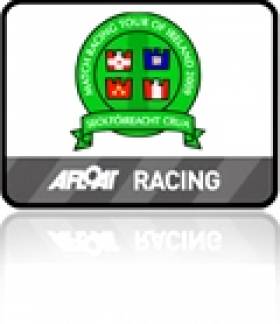Displaying items by tag: Carol O'Kelly
'Really Naughty' Win First Ever Women's Irish Match Racing Championship
The first ever ISA Women's Match Championship was completed on Sunday, October 10th at Kinsale in Ireland sailing J/80's.
Saturday racing was postponed due to the strong wind gusting up to 37 knots. An early start on Sunday morning, 09.30, proved to of be little deterrent to the ten enthusiastic sailing teams. With no delays between flights each round was completed in under two hours and the schedule was completed in the mid afternoon.

The 'Really Naughty' team with the inaugural trophy in Kinsale
The winners Laura Dillon's 'Really Naughty' team, who were unbeaten during the event, were presented with the 'Kinsale Regatta Cup' by ISA President Peter Crowley. They were followed in second place by Mary O'Loughlin and the 'Ladies Who Launch' team who beat all except the Really Naughty girls. Proving the all-round ability of an ISA bosun Sue Smithwick stepped in when one of the Ladies Who Launch had to be taken ashore for treatment. In a tiebreak on 4 points for third place 'The Sailing West Ladies' of Laura Adamson beat Carol O'Kelly and her 'NautiGals' on 4 points. In their first race one of Audrey's crew decided to try swimming west and test the teams MOB drill. She was promptly recovered by the crew of the boat and completed the day's sailing damp but unbowed. Audrey's team wore their WIMRA T-shirts for the occasion.
The race management team with International Race Officers Alan Crosbie (PRO) and Peter Crowley were busy starting and finishing a race every 12 minutes and there was no rest for the umpire team either with many matches decided by their promptly signalled protest decisions.
This was an ISAF Grade 3 Women's Match Race and all eyes will be on the next World Ranking release on October 27 to see how these teams compare on the world stage.
Final Scores
1 Laura Dillon Really Naughty 8
Crew: Catherine Ennis, Ciara Dowling, Carol O'Kelly, Breffni Jones
2 Mary O'Loughlin Ladies Who Launch 6
Crew: alice cowman, Hazel Ruane, Sam Burrows, Caoimhe Burns, Susan Smithwick
3 Audrey Adamson Sailing West Ladies 4
Crew: Chris Nolan, Michelle Rowley, Emily McManus, Laura Greer
4 Carol O'Kelly NautiGals 4
5 Alice Cowman Launched Ladies 3
6 Chris Nolan West Sailing Girls 2
7 Emma Geary Royal Cork 1
8 Frances Lynch Glandore-Kinsale 1
9 Yvonne Sheehan Emma's Choice 1
10 Choryna Kiely Kinsale Glamour 0
























































